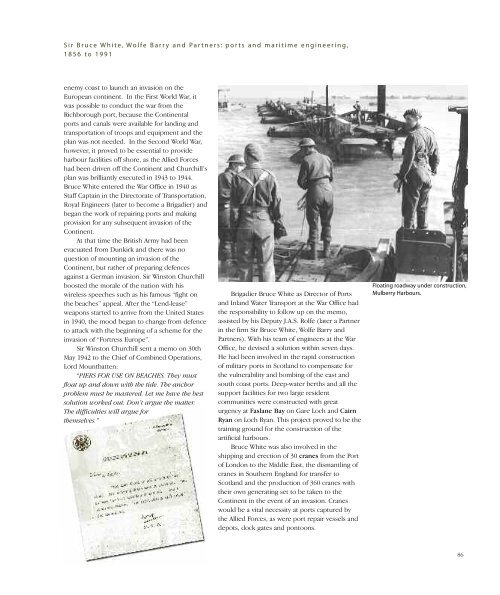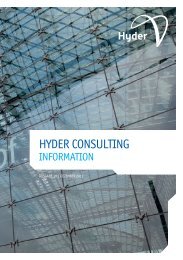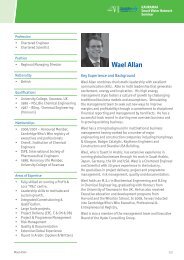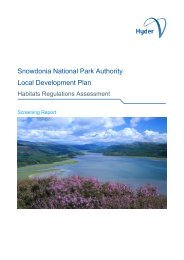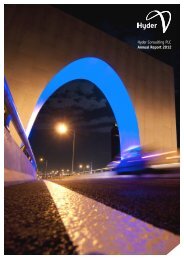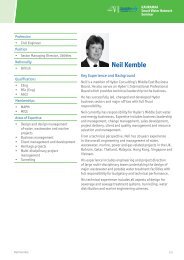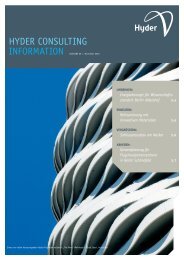John Taylor & Sons - Hyder Consulting
John Taylor & Sons - Hyder Consulting
John Taylor & Sons - Hyder Consulting
Create successful ePaper yourself
Turn your PDF publications into a flip-book with our unique Google optimized e-Paper software.
Sir Bruce White, Wolfe Barry and Partners: ports and maritime engineering,<br />
1856 to 1991<br />
enemy coast to launch an invasion on the<br />
European continent. In the First World War, it<br />
was possible to conduct the war from the<br />
Richborough port, because the Continental<br />
ports and canals were available for landing and<br />
transportation of troops and equipment and the<br />
plan was not needed. In the Second World War,<br />
however, it proved to be essential to provide<br />
harbour facilities off shore, as the Allied Forces<br />
had been driven off the Continent and Churchill’s<br />
plan was brilliantly executed in 1943 to 1944.<br />
Bruce White entered the War Office in 1940 as<br />
Staff Captain in the Directorate of Transportation,<br />
Royal Engineers (later to become a Brigadier) and<br />
began the work of repairing ports and making<br />
provision for any subsequent invasion of the<br />
Continent.<br />
At that time the British Army had been<br />
evacuated from Dunkirk and there was no<br />
question of mounting an invasion of the<br />
Continent, but rather of preparing defences<br />
against a German invasion. Sir Winston Churchill<br />
boosted the morale of the nation with his<br />
wireless speeches such as his famous “fight on<br />
the beaches” appeal. After the “Lend-lease”<br />
weapons started to arrive from the United States<br />
in 1940, the mood began to change from defence<br />
to attack with the beginning of a scheme for the<br />
invasion of “Fortress Europe”.<br />
Sir Winston Churchill sent a memo on 30th<br />
May 1942 to the Chief of Combined Operations,<br />
Lord Mountbatten:<br />
“PIERS FOR USE ON BEACHES. They must<br />
float up and down with the tide. The anchor<br />
problem must be mastered. Let me have the best<br />
solution worked out. Don’t argue the matter.<br />
The difficulties will argue for<br />
themselves.”<br />
Brigadier Bruce White as Director of Ports<br />
and Inland Water Transport at the War Office had<br />
the responsibility to follow up on the memo,<br />
assisted by his Deputy J.A.S. Rolfe (later a Partner<br />
in the firm Sir Bruce White, Wolfe Barry and<br />
Partners). With his team of engineers at the War<br />
Office, he devised a solution within seven days.<br />
He had been involved in the rapid construction<br />
of military ports in Scotland to compensate for<br />
the vulnerability and bombing of the east and<br />
south coast ports. Deep-water berths and all the<br />
support facilities for two large resident<br />
communities were constructed with great<br />
urgency at Faslane Bay on Gare Loch and Cairn<br />
Ryan on Loch Ryan. This project proved to be the<br />
training ground for the construction of the<br />
artificial harbours.<br />
Bruce White was also involved in the<br />
shipping and erection of 30 cranes from the Port<br />
of London to the Middle East, the dismantling of<br />
cranes in Southern England for transfer to<br />
Scotland and the production of 360 cranes with<br />
their own generating set to be taken to the<br />
Continent in the event of an invasion. Cranes<br />
would be a vital necessity at ports captured by<br />
the Allied Forces, as were port repair vessels and<br />
depots, dock gates and pontoons.<br />
Floating roadway under construction,<br />
Mulberry Harbours.<br />
86


